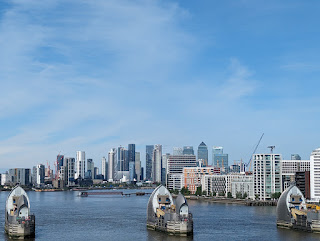If it is Friday we are in Honfleur, France. This is as close as this cruise will come to Paris, so there are three buses taking a 10 hour trip to Paris for guests to enjoy a 3 hour visit. We are heading back to Normandy and the D-Day landing, we saw Utah beach yesterday, and today we will see Omaha beach, Port Winston, Gold, Juno, and Sword beaches.




Today our tour started at the other end of the beaches that were used for D-Day. Sword beach was taken by the British, Juno by the Canadians, and Gold by the British. Winston Churchill had come up with the idea of making temporary harbors that could be set up to bring in supplies for the war during WWI, he resurrected the idea, when it was determined that the Germans had the current harbors well defended so the idea was raised again. The British set up a harbor at Gold beach within days of the landing. The Americans also set one up at Utah beach, but a weather event wiped it out before it could be useful. Ships were scuttled, and then these forms were towed into place and filled with water for a break water and areas to dock the supply ships. They also made platoon bridges to bring all the supplies to the beaches. It was very effective, and was used by the allies until early 1945 to land 2.5 million soldiers, 500,000 vehicles, and 4 million tons of supplies. Above is what is still in place 80 years later.

Above is the flag they are flying at Omaha Beach to celebrate the 80th D-Day Anniversary.
To the right you will see part of the anti tank sea wall that the Germans erected in their 4 years of occupation. They left access points, but that just improved their ability to defend a potential threat coming in from the beach.
This is a statue erected by the US armed services on one of the anniversaries.

On the right is one of the devices that were put in the Ocean that would not be seen at high tide, but if hit by a landing craft it would tip it over or damage it so it would sink, others had mines on the top. The Allies knew about these and planned to arrive at low tide so they could see the obstacles and avoid them. They also planned to have engineers in the first wave to destroy the obstacles before the tides rose and covered them and made it dangerous to continue to land the landing crafts. The Germans had made good plans to try to prevent anyone from trying to bring Armies in via the beaches.
American's who died on the beaches and surrounding areas were buried here not far from the beach. It was decided that this was not the best place, so everything was moved up on a hill, and there were numerous cemeteries around the area.
Mike is standing next to a part of the pontoon bridge from the dock to the beach. This is how supplies, jeeps, small equipment, and anything else needed was transferred from the Mulberry harbour. Note I use the British spelling of harbor.
Our last stop was at the Normandy American Cemetery. This is a beautiful peaceful 172 acre spot that was thoughtfully planned.
This is a 20 foot statue at the beginning of the tour. This area is maintained by the US, and very well presented.
Below is the ceiling above another monument in the area.
There are 20,000 crosses or star of David to mark the graves which all face West to the USA. The crosses are all identical, with the exception of 6 which one is seen in the picture to the left. The ones with the identical information written in gold are for the medal of honor recipients. The cemetery only holds a portion of the fallen solders. 60,000 where sent home to the US for burial.
If a fallen solders family comes to the cemetery, they arrive at guest services and are escorted to the grave site and a small service is performed.
The French have a volunteer group Les Fleurs de la Memoire that adopts graves of American servicemen who died during the invasion. They encourage the French families to lay flowers on the graves when American families can't do it. They are encouraged to visit and decorates their grave yearly. They are identified by a yellow band on their upper arm when visiting the grave.
It was an emotional day.
As we arrived back to the port after a more than 9 hour day of emotions. We are met by the Viking staff awaiting our return. Our bus driver and guide were the first to see this sight, and our bus driver started honking his horn. As the other drivers returned they did the same.
There was music playing, hands clapping, dancing, smiles, and a special welcome back with hot chocolate. Viking staff making every day special.
When we arrived home, and had a sleep, I awoke to find I had missed a video call from my son. There were pictures, so Mike and I were quite excited when Eric called again and we were able to meet our newest Grandchild Drew Hall Adams. He and Mom are doing great. Stats are as follows, he made his entrance into the world at 6:12 pm on May 3, 2024, 7 lbs 13.8 oz and 20 inches long. It looks like he has dark hair. Surprise Drew did not want to wait until we arrived home to make his appearance. We are happy to welcome him to the family, and can't wait to be able to hold him. Good job Katie!






























































